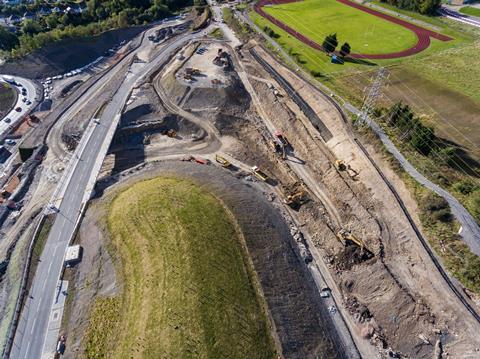The future of construction depends on our ability to work together. The challenge is significant, but the rewards are even greater.
In the construction industry, collaboration has often been seen as a luxury, a “nice to have” that, while beneficial, isn’t always prioritised.
This perspective, however, is increasingly outdated and counterproductive. In an environment where projects are growing more complex and stakes are higher than ever, collaboration is not just advantageous—it is essential.

The traditional model of isolated, siloed operations, where each stakeholder functions independently, has been a significant barrier to productivity and innovation. For the construction sector to thrive, it must embrace collaboration as the cornerstone of its future, embedding it deeply into every stage of the project lifecycle.
The urgency of this shift becomes clear when we examine the state of productivity in the construction sector.
According to the Office for National Statistics, productivity in construction has been relatively flat for decades, significantly trailing behind other industries.
This stagnation has persisted despite numerous technological advancements and the increasing complexity of projects. While a lack of investment in research and development and the slow uptake of digital tools are frequently cited as reasons for this stagnation, a more pervasive issue lies in the industry’s traditional reluctance to collaborate.

The construction process, by its very nature, involves numerous stakeholders—clients, contractors, suppliers, service providers, and end-users—each bringing their own objectives, expertise, and constraints. Without a collaborative framework that aligns these diverse interests, the potential for inefficiencies, waste, and suboptimal outcomes increases exponentially.
Recognising this, the UK government’s Infrastructure Projects Authority has made collaboration a central tenet of its Transforming Infrastructure Performance (TIP) 2030 programme and the Construction Playbook.
These initiatives advocate for a values-led approach to infrastructure development, where collaboration, underpinned by data-driven decision-making, is key to delivering successful outcomes.
The TIP programme, for instance, emphasises the importance of gathering comprehensive data from service providers and other sources to inform decision-making processes.
This data-driven approach is designed to foster collaboration from the outset, ensuring that all stakeholders have a shared understanding of the project’s objectives and challenges.
However, for collaboration to be truly effective, it must begin at the very start of a project and continue through every phase of delivery. Early engagement between clients, service providers, and other stakeholders is crucial for building a strong foundation of trust and mutual understanding.
This collaborative approach enables more accurate problem identification, clearer articulation of project goals, and the development of delivery strategies that are well-aligned with the needs and expectations of all parties involved. By engaging stakeholders early and often, projects can avoid the pitfalls of miscommunication, scope creep, and rework—issues that are all too common in traditional, siloed project environments.

One of the most promising developments in this regard is the rise of collaborative contracting arrangements. Supplier frameworks, alliance agreements, and other forms of collaborative contracts are increasingly being used to foster closer cooperation between clients and their supply chains.
These contracts are designed to create a more cooperative, less adversarial environment, where the interests of all parties are aligned toward achieving the best possible outcomes.
For example, in alliance-type agreements, stakeholders work together under a “head agreement” that outlines the principles of collaboration, which are then reflected in individual project contracts.
This approach helps to standardise processes, promote the use of off-site manufacturing, encourage lean construction practices, and support the adoption of digital tools—each of which is crucial for improving productivity and delivering high-quality outcomes.
However, it’s important to note that simply having a collaborative contract in place does not guarantee a collaborative environment.
The success of these arrangements depends on the genuine commitment of all parties to work together, share information openly, and prioritise the overall success of the project over individual gains. Without this commitment, collaborative contracts can quickly become just another layer of bureaucracy, adding administrative burdens rather than driving innovation and efficiency.
The stakes for getting this right are high. Central government, which often funds large-scale infrastructure projects, faces the ongoing challenge of balancing investments between social and economic infrastructure.
These projects are vital for the nation’s well-being, whether they involve building hospitals, schools, transportation networks, or sustainable energy facilities.
When these projects experience delays, cost overruns, or fail to deliver on their intended outcomes, the repercussions are felt not just by the immediate stakeholders, but by society at large. Therefore, the construction industry has both an opportunity and a responsibility to create a more stable, predictable delivery environment.
"The question we must ask ourselves is: are we ready to fully embrace collaboration as the foundation of our industry? We’ve seen progress, but it’s not enough."
Achieving this stability requires a collective effort from all stakeholders—clients, consultants, contractors, suppliers, manufacturers, and service providers—to engage in a way that is genuinely collaborative, setting clear expectations and working toward shared goals.
Collaboration is not the easy path. It demands a cultural shift where stakeholders are willing to set aside their own interests and biases for the greater good of the project.
It requires strong leadership, transparent communication, and a commitment to shared objectives. But the benefits are profound.
By working together in a truly collaborative manner, we can simplify the complexity of large-scale programs, reduce the risks of delays and cost overruns, and ultimately deliver projects that meet or exceed expectations.

The need for collaboration in construction is not a new revelation. As early as 1934, Alfred Bossom criticised the industry for its adversarial nature in his book “Reaching for the Skies.”
Since then, we’ve seen a steady stream of reports and initiatives—Latham’s Constructing the Team in 1994, Egan’s Rethinking Construction in 1998, and more recently, Mark Farmer’s Modernise or Die in 2016—each emphasising the importance of collaboration.
These reports have consistently pointed to the same conclusion: the construction industry’s full potential can only be realised through collaboration. Despite this, true collaboration remains elusive. The problem isn’t that we don’t know what needs to be done; it’s that we haven’t fully committed to doing it.
As we move further into the 21st century, the pressures on the construction industry are intensifying.
The pace of technological change is accelerating, and the demands for more sustainable, socially responsible infrastructure are growing.
At the same time, the industry faces significant challenges related to resource scarcity, labour shortages, and geopolitical instability. In this context, the old ways of doing things simply won’t cut it. The construction industry must evolve, and at the heart of this evolution must be a renewed commitment to collaboration.
The question we must ask ourselves is: are we ready to fully embrace collaboration as the foundation of our industry? We’ve seen progress, but it’s not enough.
The world around us is changing rapidly, and if the construction sector is to keep pace, we need to accelerate our adoption of collaborative practices. We need to move beyond seeing collaboration as a “nice to have” and start recognising it as the critical ingredient for success in the modern world.
The future of construction depends on our ability to work together. The challenge is significant, but the rewards are even greater. If we can rise to this challenge, we can build not only better buildings and infrastructure but a better industry—one that is more productive, more innovative, and more capable of delivering the outcomes that society needs. The time for collaboration is now. Let’s step up and make it happen.
Terry Stocks is the director of property UK&I for project and programme services at AtkinsRéalis



























No comments yet